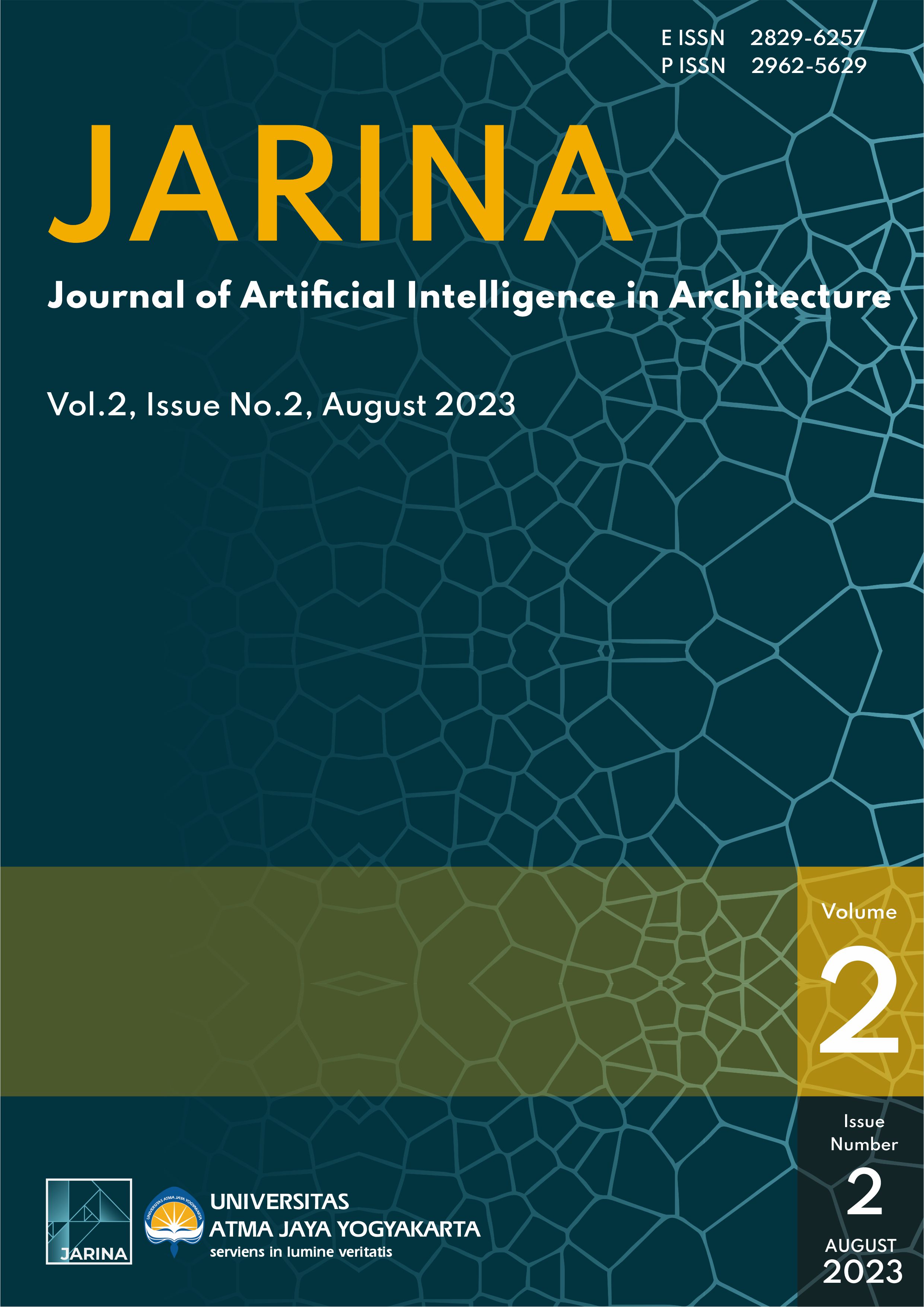Utilizing the Use of Google Trends to Discover The Architectural Attractiveness of a Place in Indonesia
DOI:
https://doi.org/10.24002/jarina.v2i2.7483Keywords:
Google Trends, Branding, Architecture, Traveling , HealingAbstract
A person's memory of the image of a place is powerful, which is influenced by a uniqueness supported by continuity of information. Every visitor's image will be very subjectively evaluated through the internet information media. The challenge lies in subjective perception through internet media information which only sometimes leads to real quality due to perceptions formed from the continuity of information received. A shift in meaning allegedly led to a phenomenon of similar motivation between video game users and traveling for healing purposes. From the perspective of a Google search, the word "traveling" refers to buildings and places with ecological and natural concepts. Meanwhile, video games also offer a natural concept but are more competitive. Using Google Trends, this study attempts to formulate city popularity data using the keyword "traveling." Natural Ecology is the highest choice for social media users, and "healing" is the primary motivation. The value of natural architectural instruments can be a focus to support a sustainable development process for a place based on the popularity of today's needs.
References
F. Anshari and N. M. Prastya, “Media Sosial Sebagai Sarana Branding Politisi ( Studi Terhadap Akun Media Sosial Presiden Susilo Bambang Yudhoyono ),” pp. 1–9, 2014.
P. Ciuccarelli, G. Lupi, and L. Simeone, Visualizing the Data City Social Media as a Source of Knowledge for Urban Planning and Management. 2014.
R. Fullerton, “the Impact of Social Media on Marketing Strategy,” Dissertation, vol. 15, no. February, pp. 91–95, 2011.
P. M. Dahlgren, “A critical review of filter bubbles and a comparison with selective exposure,” Nord. Rev., vol. 42, pp. 15–33, 2021.
L. Caprioli, M. Larson, R. Ek, and C. S. Ooi, “The inevitability of essentializing culture in destination branding: the cases of fika and hygge,” J. Place Manag. Dev., 2021, doi: 10.1108/JPMD-12-2019-0114.
A. E. Kirby and A. M. Kent, “Architecture as brand: Store design and brand identity,” J. Prod. Brand Manag., vol. 19, no. 6, pp. 432–439, 2010, doi: 10.1108/10610421011085749.
O. D. Sanitha and M. Rahadiyanti, “Place Branding : From Digital Architecture and Digital Entertainment to Instrumental Value,” 2022, vol. 671, no. Iweda 2021, pp. 214–219, doi: 10.2991/assehr.k.220703.039.
O. D. Sanitha, V. G. S. Rejeki, and A. R. Soesilo, “BRAND DAN ARSITEKTUR DALAM TUNTUTAN PASAR GLOBAL KONTEKS : BANGUNAN KOMERSIAL,” J. Lingk. (Lingkungan Arsitektur), vol. 1, no. 1, pp. 16–26, 2022, doi: https://doi.org/10.37477/lkr.v1i1.238.
A. Klingmann, “Brandscapes: Architecture in the Experience Economy,” pp. 53–54, 2008.
G. Dinis, Z. Breda, and C. Costa, “Google Trends in tourism and hospitality research : a systematic literature review,” vol. 10, no. 4, pp. 747–763, 2019, doi: 10.1108/JHTT-08-2018-0086.
H. Wang, “Analysis on the Changes in Consumer Behavior and Marketing Countermeasure,” vol. 01007, 2015.
A. (2009) 2009. Kaushik, Web Analytics 2.0. 1st ed. Wiley., 1st ed. Sybex, 2009.
M. Zimmer, “The Gaze of the Perfect Search Engine: Google as an Infrastructure of Dataveillance,” pp. 77–99, 2008, doi: 10.1007/978-3-540-75829-7_6.
Statista.com, “Worldwide desktop market share of leading search engines from January 2010 to July 2022,” 2022. https://www.statista.com/statistics/216573/worldwide-market-share-of-search-engines/#:~:text=Ever since the introduction of,revenues are generated through advertising. (accessed Dec. 26, 2022).
Google Support, “Search Trends on the Insights Page.” https://support.google.com/google-ads/answer/10261137?hl=en (accessed Dec. 26, 2022).
H. Ö. Çekim and A. Koyuncu, “The Impact of Google Trends on the Tourist Arrivals: A Case of Antalya Tourism,” Alphanumeric J., vol. 10, no. 1, pp. 1–14, 2022, doi: 10.17093/alphanumeric.931652.
F. W. Yee, “Nation branding: A case study of Singapore,” UNLV Theses, Diss. Prof. Pap. Capstones, pp. 1–712, 2009, [Online]. Available: https://digitalscholarship.unlv.edu/cgi/viewcontent.cgi?article=1713&context=thesesdissertations.
A. Mutohharoh, “Self Healing : Terapi atau Rekreasi?,” JOUSIP J. Sufism Psychother., vol. 2, no. 1, pp. 73–88, 2022, [Online]. Available: http://e-journal.iainpekalongan.ac.id/index.php/jousip/article/view/5771.
H. K. Nafah and E. Purnaningrum, “Seminar Nasional Hasil Riset dan Pengabdian Ke-III (SNHRP-III 2021) PENGGUNAAN BIG DATA MELALUI ANALISIS GOOGLE TRENDS UNTUK MENGETAHUI PERSPEKTIF PARIWISATA INDONESIA DI MATA DUNIA,” 2021, pp. 430–436, [Online]. Available: https://trends.google.com/trends/?geo=US.
Google News Initiative, “Google Trends: Understanding the data,” 2019. [Online]. Available: https://storage.googleapis.com/gweb-news-initiative-training.appspot.com/upload/GO802_NewsInitiativeLessons_Fundamentals-L04-GoogleTrends_1saYVCP.pdf.
A. Boldi, A. Rapp, and M. Tirassa, “Playing during a crisis: The impact of commercial video games on the reconfiguration of people’s life during the COVID-19 pandemic,” Human–Computer Interact., pp. 1–42, Mar. 2022, doi: 10.1080/07370024.2022.2050725.
M. (Miki) Klein, D. Regev, and S. Snir, “Using the clay slip game in art therapy: a sensory intervention,” Int. J. Art Ther., vol. 25, no. 2, pp. 64–75, Apr. 2020, doi: 10.1080/17454832.2020.1713833.
R. Bhalla, N. Chowdhary, and A. Ranjan, “Spiritual tourism for psychotherapeutic healing post COVID-19,” J. Travel Tour. Mark., vol. 38, no. 8, pp. 769–781, Oct. 2021, doi: 10.1080/10548408.2021.1930630.
U. Stankov and V. Filimonau, “Here and now – the role of mindfulness in post-pandemic tourism,” Tour. Geogr., pp. 1–16, Dec. 2021, doi: 10.1080/14616688.2021.2021978.
D. Jamshidi, A. Rousta, and R. Shafei, “Social media destination information features and destination loyalty: does perceived coolness and memorable tourism experiences matter?,” Curr. Issues Tour., pp. 1–22, Dec. 2021, doi: 10.1080/13683500.2021.2019204.
V. A. Crooks, I. G. Cohen, K. Adams, R. Whitmore, and J. Morgan, “Inbound medical tourism to Barbados : a qualitative examination of local lawyers ’ prospective legal and regulatory concerns,” BMC Health Serv. Res., no. December, 2015, doi: 10.1186/s12913-015-0948-3.
S. John, R. Larke, M. Kilgour, S. John, and R. Larke, “Applications of social media for medical tourism marketing : an empirical analysis empirical analysis,” Anatolia, vol. 00, no. 00, pp. 1–13, 2018, doi: 10.1080/13032917.2018.1473261.
N. Papadopoulos, M. Cleveland, B. Bartikowski, and A. Yaprak, “Of countries, places and product/brand place associations: an inventory of dispositions and issues relating to place image and its effects,” J. Prod. Brand Manag., vol. 27, no. 7, pp. 735–753, 2018, doi: 10.1108/JPBM-09-2018-2035.
G. E. Richardson and N. L. Jose, “Simulation Mind Games,” Health Educ., vol. 13, no. 2, pp. 45–46, Apr. 1982, doi: 10.1080/00970050.1982.10614290.
A. S. M. Venigalla, D. Vagavolu, and S. Chimalakonda, “SurviveCovid-19 - An Educational Game to Facilitate Habituation of Social Distancing and Other Health Measures for Covid-19 Pandemic,” Int. J. Human–Computer Interact., vol. 38, no. 16, pp. 1563–1575, Oct. 2022, doi: 10.1080/10447318.2021.2009183.
K. Koban, J. Biehl, J. Bornemeier, and P. Ohler, “Compensatory video gaming. Gaming behaviours and adverse outcomes and the moderating role of stress, social interaction anxiety, and loneliness,” Behav. Inf. Technol., vol. 41, no. 13, pp. 2727–2744, Oct. 2022, doi: 10.1080/0144929X.2021.1946154.
D. Nutt and D. Railton, “The Sims: Real Life as Genre,” Information, Commun. Soc., vol. 6, no. 4, pp. 577–592, Dec. 2003, doi: 10.1080/1369118032000163268.
Y. B. Mangunwijaya, Wastu Citra. Jakarta: PT. Gramedia Pustaka Utama, 2009.
B. Flowers, “The International Journal of the History of Sport Stadiums : Architecture and the Iconography of the Beautiful Game,” no. October 2014, pp. 37–41, 2011, doi: 10.1080/09523367.2011.567770.
M. Paterson and M. Paterson, “More-than visual approaches to architecture . Vision , touch , technique More-than visual approaches to architecture . Vision , touch , technique,” no. October 2014, pp. 37–41, 2011, doi: 10.1080/14649365.2011.564733.

Downloads
Published
How to Cite
Issue
Section
License
Copyright (c) 2023 Onie Dian Sanitha, Novera Kristianti, Theo Fransisco, Yunida Iashania

This work is licensed under a Creative Commons Attribution 4.0 International License.
Authors who publish with this journal agree to the following terms:
1.Authors retain copyright and grant the journal right of first publication with the work simultaneously licensed under a Creative Commons that allows others to share the work with an acknowledgement of the work's authorship and initial publication in this journal.
2.Authors are able to enter into separate, additional contractual arrangements for the non-exclusive distribution of the journal's published version of the work (e.g., post it to an institutional repository or publish it in a book), with an acknowledgement of its initial publication in this journal.
3.Authors are permitted and encouraged to post their work online (e.g., in institutional repositories or on their website) prior to and during the submission process, as it can lead to productive exchanges, as well as earlier and greater citation of published work (See The Effect of Open Access).
















